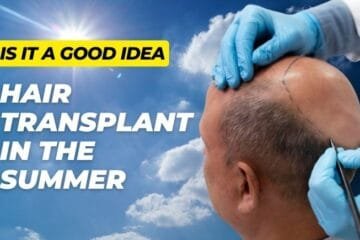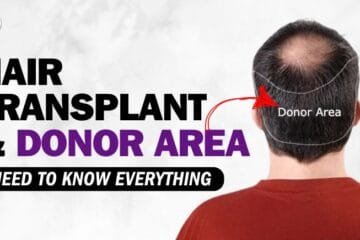Hair loss is a common concern for many individuals, affecting their self-confidence and overall well-being. Fortunately, advancements in medical technology have paved the way for effective hair restoration solutions. One such solution is follicular unit extraction (FUE) hair transplantation. In this comprehensive guide, we will delve into the details of what FUE hair transplant is, how it works, its benefits and risks, frequently asked questions, and much more. Whether you’re experiencing hair loss or are simply curious about the procedure, this article will provide you with valuable insights to help you make an informed decision.
Understanding Hair Loss:
Hair loss is a common concern for many individuals, and it can be attributed to various causes. Understanding the underlying factors is essential in determining the most appropriate treatment approach. Let’s explore some common causes of hair loss:
- Genetic Factors: Hair loss with a hereditary component is known as androgenetic alopecia or pattern baldness. It is the most common type of hair loss, affecting both men and women. Genetic predisposition determines the sensitivity of hair follicles to dihydrotestosterone (DHT), a hormone that leads to hair thinning and miniaturization over time.
- Hormonal Imbalances: Hormonal changes can significantly impact hair growth and lead to hair loss. For example, an imbalance in androgen hormones, such as testosterone and DHT, can contribute to hair thinning. Hormonal fluctuations can occur during pregnancy, menopause, or as a result of certain medical conditions.
- Medical Conditions: Various medical conditions and underlying health issues can trigger hair loss. These include:
- Thyroid disorders (e.g., hypothyroidism or hyperthyroidism)
- Scalp infections (e.g., ringworm)
- Autoimmune conditions (e.g., alopecia areata)
- Nutritional deficiencies (e.g., iron, vitamin D, or biotin deficiency)
- Chronic illnesses or high fever
- Side effects of certain medications (e.g., chemotherapy drugs)
- Lifestyle and Environmental Factors: Certain lifestyle choices and environmental factors can contribute to hair loss. These include:
- Poor nutrition and inadequate intake of essential nutrients
- High levels of stress and anxiety
- Excessive use of hairstyling products, heat, or chemical treatments
- Tight hairstyles that exert traction on the hair follicles (e.g., tight ponytails or braids)
- Exposure to environmental pollutants and toxins
It’s important to note that hair loss can be a complex issue influenced by multiple factors. Consulting with a medical professional or a hair transplant specialist can help identify the specific cause of hair loss and determine the most suitable treatment options.
Remember, early intervention and seeking appropriate medical advice can greatly improve the chances of successful hair restoration.
Common Types of Hair Loss:
- Androgenetic Alopecia (Pattern Baldness): Androgenetic alopecia, also known as pattern baldness, is the most common type of hair loss. It follows a predictable pattern and is influenced by genetic and hormonal factors. In men, it typically presents as a receding hairline and thinning at the crown. In women, it often leads to overall thinning of the hair.
- Alopecia Areata: Alopecia areata is an autoimmune condition characterized by patchy hair loss. The immune system mistakenly attacks the hair follicles, causing hair to fall out in small, round patches. In some cases, it can progress to total hair loss on the scalp (alopecia totalis) or even loss of all body hair (alopecia universalis).
- Telogen Effluvium: Telogen effluvium is a temporary hair loss condition characterized by excessive shedding of hair. It occurs when a significant number of hair follicles prematurely enter the telogen (resting) phase of the hair growth cycle. Common triggers include stress, hormonal changes, nutritional deficiencies, illness, or certain medications. Hair usually regrows spontaneously after the underlying cause is addressed.
- Traction Alopecia: Traction alopecia is hair loss that occurs due to constant tension or pulling on the hair. Tight hairstyles that put pressure on the hair follicles, such as ponytails, braids, or hair extensions, frequently cause it. Prolonged traction can lead to hair thinning and even permanent damage if not addressed.
It’s important to note that these are just a few examples of common types of hair loss. Other conditions, such as trichotillomania (hair-pulling disorder) or scarring alopecia, may also cause hair loss. Consulting with a dermatologist or hair transplant specialist can help accurately diagnose the type of hair loss and determine appropriate treatment options.
Remember, early intervention and proper management of hair loss can improve outcomes and help individuals regain their confidence and a healthy head of hair.
Psychological Impact of Hair Loss:
Hair loss can have a significant psychological impact on individuals, affecting various aspects of their well-being. Let’s explore some of the common psychological effects associated with hair loss:
- Effects on Self-Confidence and Self-Image: Hair plays a crucial role in shaping our identity and self-image. Experiencing hair loss can lead to a decline in self-confidence and self-esteem. Many individuals feel less attractive or worry about being perceived as older or less desirable. Hair loss can also impact one’s perception of femininity or masculinity, further affecting self-image.
- Emotional Distress and Anxiety: Hair loss can be emotionally distressing, leading to feelings of sadness, frustration, or even depression. The visible change in appearance and the uncertainty of hair loss progression can create anxiety and a sense of loss of control. Individuals may experience a negative impact on their overall emotional well-being and quality of life.
- Social Implications: Hair loss can influence social interactions and relationships. Some individuals may feel self-conscious or embarrassed, leading to withdrawal from social activities or avoiding situations where their hair loss may be more noticeable. This can result in a reduced quality of social life and potential limitations in personal and professional settings.
It’s important to address the psychological impact of hair loss alongside any treatment options considered. Seeking emotional support from loved ones or professional counselors can help individuals cope with the emotional challenges associated with hair loss.
Keep in mind that there are effective treatments available for hair loss, which is a common problem for many people. Understanding the psychological impact and seeking appropriate support can contribute to a holistic approach to hair restoration and overall well-being.
Read this article: Unlock the Secret to Strong and Shiny Hair
The Basics of FUE Hair Transplant
What is FUE Hair Transplant?
FUE hair transplant, short for Follicular Unit Extraction Hair Transplant, is a surgical procedure that involves the extraction of individual hair follicles from a donor area and their transplantation into the recipient area experiencing hair loss. Unlike traditional hair transplant methods that use a strip of hair-bearing scalp, FUE utilizes a minimally invasive approach, resulting in a more natural-looking outcome with minimal scarring.
FUE is a highly precise and delicate procedure that requires specialized training and expertise. The success of FUE hair transplants largely depends on the skill and experience of the surgeon, as well as the quality and quantity of hair in the donor area. Choosing the right clinic is essential for a successful FUE hair transplant.
How Does FUE Hair Transplant Work?
The FUE hair transplant procedure consists of several key steps:
1. Extraction of Hair Follicles
During an FUE hair transplant, a skilled surgeon or technician begins by carefully extracting individual hair follicles from the donor area. The donor area is typically located at the back or sides of the scalp, where hair growth is genetically resistant to balding. Each hair follicle is carefully harvested using a specialized micro-punch tool, leaving tiny, inconspicuous holes.
2. Preparation of the Recipient Area
After the hair follicles are extracted, the recipient area is prepared for transplantation. The recipient area is the region of the scalp experiencing hair loss or thinning. The surgeon creates small incisions in the recipient area, strategically placing them to achieve a natural hairline and optimal hair density.
3. Transplantation of Hair Follicles
Once the recipient area is prepared, the extracted hair follicles are meticulously transplanted into the incisions. The surgeon ensures that the angle and direction of each transplanted hair follicle mimic the natural growth pattern, creating a seamless and undetectable result. The transplanted hair follicles will continue to grow naturally, just like the rest of your hair.
Benefits of FUE Hair Transplant
FUE hair transplant offers several benefits that make it a preferred choice for individuals seeking hair restoration. Some of the key benefits include:
1. Natural-Looking Results
One of the primary advantages of FUE hair transplants is the natural-looking results they offer. Since the procedure involves the transplantation of individual hair follicles, the outcome closely resembles the natural growth pattern. The transplanted hair blends seamlessly with your existing hair, providing a full and realistic appearance.
2. Minimally Invasive Procedure
Compared to traditional hair transplant methods, FUE is a minimally invasive procedure. The absence of a linear incision in the donor area means less discomfort and a faster healing time. Additionally, the small puncture marks from follicle extraction typically heal quickly and are barely noticeable, allowing you to resume your daily activities sooner.
3. No Visible Scarring
Unlike older techniques that left noticeable linear scars, FUE hair transplants leave no visible scarring. The micro-punch tool used in FUE leaves tiny, scattered puncture marks that fade over time. These marks are virtually undetectable, even with short hairstyles, giving you the freedom to wear your hair however you like.
4. Faster Recovery
Due to its minimally invasive nature, FUE hair transplant offers a faster recovery time compared to traditional methods. Most individuals can return to work and their regular routines within a few days with minimal discomfort.
5. Long-Lasting Results
The results of FUE hair transplants are considered permanent. The transplanted hair follicles are typically resistant to the hormone responsible for hair loss, ensuring long-lasting results. However, it’s important to note that the natural aging process may cause some thinning or loss of non-transplanted hair over time.
6. Versatile and Suitable for Various Hair Loss Cases
FUE hair transplant is a versatile procedure that can address different degrees of hair loss. Whether you have receding hairlines, thinning crowns, or bald patches, FUE can be customized to meet your specific needs and goals.
Overall, FUE hair transplant is a safe and effective hair restoration technique that can help individuals regain their confidence and achieve a fuller head of hair.
Potential Risks and Complications
While FUE hair transplants are generally safe and well tolerated, it’s essential to be aware of potential risks and complications. These may include:
1. Infection
As with any surgical procedure, there is a risk of infection. However, when a skilled and experienced surgeon performs the procedure in a sterile setting, the likelihood of infection is minimal. Strict post-operative care instructions should be followed to minimize the risk of infection.
2. Bleeding
Some mild bleeding may occur during the procedure and in the immediate postoperative period. However, excessive bleeding is rare. The surgeon will take the necessary precautions to control bleeding and ensure your safety.
3. Scarring
Although FUE hair transplants leave minimal scarring compared to older techniques, it’s essential to remember that scarring can still occur. However, the tiny puncture marks from follicle extraction are usually tiny and fade over time, resulting in minimal visibility.
4. Shock Loss
Shock loss refers to the temporary shedding of existing hair in the recipient area after the transplant. It’s a normal part of the hair transplant process, and the hair usually grows back within a few months. The transplanted hair follicles, however, continue to grow naturally.
5. Poor Growth or Unsatisfactory Results
In some cases, the transplanted hair may not grow as expected or may not meet the patient’s desired outcome. Factors such as improper graft placement, inadequate blood supply, or poor patient candidacy can contribute to unsatisfactory results. Consulting with a qualified hair restoration specialist and following their recommendations can help minimize this risk.
How FUE Differs from Other Hair Transplant Methods?
Follicular Unit Extraction (FUE) differs from other hair transplant methods, such as Follicular Unit Transplantation (FUT), in several ways:
- Contrasting FUE with Follicular Unit Transplantation (FUT): FUE and FUT are the two primary techniques used in hair transplantation. FUT, also known as the strip method, involves surgically removing a strip of scalp tissue from the donor area and then dissecting it into individual follicular units for transplantation. In contrast, FUE involves the extraction of individual hair follicles directly from the donor area, without the need for a strip of scalp tissue removal.
- No Linear Scar with FUE: One of the significant advantages of FUE over FUT is that it does not leave a linear scar at the donor area. In FUT, the linear incision is closed with sutures or staples, resulting in a linear scar that may be visible if the hair is cut short. FUE, on the other hand, involves tiny, circular punches to extract individual follicles, leaving small, dot-like scars that are barely visible even with short hairstyles.
- Less Downtime and Faster Recovery Compared to Other Methods: FUE is a minimally invasive procedure that typically requires less downtime and allows for a faster recovery compared to other hair transplant methods. Since FUE does not involve a large incision or sutures, patients experience less post-operative discomfort, and the healing process is generally quicker. This means that individuals can resume their daily activities sooner after an FUE hair transplant.
It’s important to note that the choice between FUE and other hair transplant methods depends on various factors, including the patient’s specific needs, the extent of hair loss, and the availability of donor hair. Consulting with a hair transplant specialist can help determine the most suitable method based on individual circumstances.
FUE’s ability to provide natural-looking results, its scar-minimizing benefits, and its quicker recovery makes it a popular choice for many individuals seeking hair restoration.
Preparing for an FUE Hair Transplant:
1. Consultation with a Hair Transplant Specialist:
Before undergoing an FUE hair transplant, it is essential to schedule a consultation with a hair transplant specialist. During this consultation, several key aspects will be addressed:
- Initial assessment and evaluation of hair loss: The specialist will assess the extent and pattern of your hair loss. They will examine the donor area, which is usually located at the back or sides of the head, to determine its suitability for transplantation.
- Discussion of expectations and goals: You will have the opportunity to discuss your expectations and desired outcomes. The specialist will provide insights into what can realistically be achieved with FUE hair transplants and will manage your expectations accordingly.
- Creation of a personalized treatment plan: Based on the assessment and discussion, the specialist will create a personalized treatment plan tailored to your specific needs. This plan will outline the number of grafts required, the hairline design, and the overall approach for achieving the desired results.
2. Evaluation of the Donor Area and Recipient Area:
During the pre-operative phase, the hair transplant specialist will thoroughly evaluate both the donor area and the recipient area:
- Assessment of hair density and quality in the donor area: The specialist will assess the density, thickness, and quality of the hair in the donor area to determine the number of grafts that can be safely harvested without compromising the donor site’s aesthetics.
- Mapping the recipient area to determine graft placement: The recipient area, which has experienced hair loss, will be carefully examined and mapped. The specialist will determine the optimal placement of the grafts to achieve a natural-looking result and maximize hair density in the areas of concern.
3. Pre-operative Instructions and Guidelines:
To ensure a successful FUE hair transplant, you will receive pre-operative instructions and guidelines to follow:
- Guidelines on medications and supplements: You may be advised to avoid certain medications or supplements that can interfere with the procedure or increase the risk of complications. It is crucial to inform the specialist about any medications or supplements you are currently taking.
- Instructions on avoiding smoking and alcohol: Smoking and alcohol consumption can negatively impact the healing process and graft survival. It is generally recommended to refrain from smoking and alcohol for a specified period before the procedure.
- Recommendations for a healthy lifestyle before the procedure: The specialist may provide recommendations on maintaining a healthy lifestyle, including a balanced diet and regular exercise. Good overall health can contribute to better outcomes and faster recovery.
By following the pre-operative instructions and guidelines, you can optimize the conditions for a successful FUE hair transplant and enhance your chances of achieving the desired results.
Remember, proper preparation and communication with your hair transplant specialist are crucial steps in ensuring a smooth and effective FUE hair transplant experience.
The FUE Hair Transplant Procedure:
1. Overview of the FUE Procedure Steps:
The FUE hair transplant procedure involves several key steps:
- Administration of local anesthesia: Before the procedure begins, the donor and recipient areas are numbed using local anesthesia to ensure a comfortable experience.
- Extraction of hair follicles using micro punches: The hair transplant specialist uses small, specialized micro punches (typically less than 1mm in diameter) to extract individual hair follicles from the donor area. These punches are carefully inserted around each follicular unit to minimize damage to the surrounding tissues.
- Preparation of the recipient area for transplantation: While the extracted follicles are being prepared for transplantation, the recipient area is prepared by making small incisions or slits where the grafts will be placed. The specialist takes into account the natural hair growth patterns and designs the hairline and overall aesthetic appearance.
- Implantation of hair follicles into the recipient area: The hair follicles are then strategically implanted into the recipient area, following the design and plan determined during the pre-operative stage. The specialist ensures proper angulation and orientation of the grafts to achieve a natural-looking result.
2. Extraction of Hair Follicles:
- Explanation of the punch tool used: The punch tool used in FUE hair transplant has a sharp, hollow needle-like structure that allows for the precise extraction of individual follicular units. The tool is designed to minimize trauma to the surrounding tissues and facilitate the extraction process.
- Extraction process and preservation of grafts: The punch tool is carefully inserted around each hair follicle, and with a gentle rotational motion, the follicle is freed from the surrounding tissue. The extracted follicles are then collected and preserved in a suitable solution to maintain their viability until they are implanted.
- Ensuring the donor area remains cosmetically unaffected: The extraction process is performed meticulously to ensure that the donor area remains cosmetically unaffected. The tiny, dot-like scars from the extractions are typically well-hidden within the surrounding hair, making them virtually undetectable.
3. Preparation of the Recipient Area:
- Making small incisions or slits for graft placement: Using specialized instruments, the hair transplant specialist makes small incisions or slits in the recipient area. The size and angle of these incisions are crucial to ensuring proper graft placement and natural hair growth.
- Taking into account natural hair growth patterns: The specialist considers the natural hair growth patterns and angles in the recipient area to ensure that the transplanted hair blends seamlessly with the existing hair.
- Designing the hairline and overall aesthetic appearance: The design of the hairline is an essential aspect of the recipient area preparation. The specialist works closely with the patient to create a hairline that suits their facial features and achieves the desired aesthetic outcome.
4. Implantation of Hair Follicles:
- Strategic placement of grafts for optimal density: The hair follicles are strategically placed into the recipient area, ensuring optimal density and coverage. The specialist considers factors such as hairline placement, hair direction, and overall hair distribution to achieve natural-looking results.
- Ensuring proper angulation and orientation: Each graft is meticulously placed at the correct angle and orientation to mimic the natural growth pattern of the patient’s hair. This attention to detail helps achieve a seamless and undetectable outcome.
- Maintaining a natural-looking hairline: Special care is taken during the implantation process to create a natural-looking hairline. The specialist carefully places the grafts in a way that mimics the natural irregularities and variations seen in a genuine hairline.
5. Duration and Expected Outcomes of the Procedure:
- Timeframe for the procedure based on graft quantity: The duration of the FUE hair transplant procedure can vary depending on the number of grafts being transplanted. It can range from a few hours for smaller sessions to a full day for larger sessions involving a higher number of grafts.
- Immediate post-procedure appearance: Immediately after the procedure, the transplanted area may appear red and slightly swollen. This is a normal and temporary response to the surgery. Any discomfort can be managed with prescribed pain medication if needed.
- Expected timeline for hair growth and final results: Following the FUE hair transplant, the transplanted hair follicles will enter a resting phase, and the initial transplanted hair will be shed. This is a normal part of the process, and new hair growth will typically start within a few months. It can take 9-12 months or longer for the full results to become apparent as the transplanted hair gradually grows in thickness, length, and density.
It’s important to note that individual experiences may vary, and it’s essential to follow the post-operative care instructions provided by the hair transplant specialist to ensure optimal healing and hair growth.
Recovery and Post-Operative Care:
1. Immediate Post-Operative Care Instructions:
- Medications for pain management and prevention of infection: After an FUE hair transplant, your hair transplant specialist will provide you with specific instructions regarding medications.
- This may include pain medication to manage any discomfort or soreness during the initial recovery period.
- Additionally, you may be prescribed antibiotics to prevent infection and promote proper healing. It’s critical to follow your doctor’s instructions regarding the medication regimen.
2. Post-Operative Care Guidelines:
- Gentle handling of the transplanted area: It is crucial to handle the transplanted area with care during the initial recovery phase. Avoid touching, scratching, or rubbing the transplanted area to prevent dislodging the grafts and disrupting the healing process.
- Avoidance of strenuous activities: It is generally advised to avoid rigorous physical activities, heavy lifting, or strenuous exercise for a certain period after the procedure. This allows the body to focus its energy on healing and prevents excessive sweating or strain that may affect the grafts.
- Protection from sun exposure: Protecting the transplanted area from direct sun exposure is important during the early stages of recovery. Sunscreen, a hat, or a protective covering can be used to shield the area from harmful UV rays.
- Follow-up appointments: Your hair transplant specialist will schedule follow-up appointments to monitor your progress and assess the healing process. It is essential to attend these appointments as scheduled to ensure that everything is progressing as expected.
- Gentle hair washing: Your specialist will provide instructions on when and how to wash your hair after the procedure. Generally, gentle washing techniques and mild shampoos are recommended to avoid dislodging the grafts and to maintain a clean and healthy scalp.
- Avoidance of smoking and alcohol: Smoking and alcohol consumption can negatively impact the healing process and graft survival. It is advisable to refrain from smoking and drinking alcohol during the recovery phase as instructed by your specialist.
- Patience during the hair growth process: It’s important to understand that hair growth after an FUE hair transplant takes time. Patience is key as the transplanted hair follicles go through their growth cycle. It may take several months before you start noticing significant hair growth, and the final results may take up to a year to fully manifest.
Following these post-operative care guidelines is crucial for optimal healing and the best possible outcome of your FUE hair transplant procedure. Remember to consult with your hair transplant specialist for personalized instructions based on your specific needs and circumstances.
Conclusion:
FUE hair transplant is a groundbreaking solution for individuals struggling with hair loss. By utilizing the latest techniques and technology, this minimally invasive procedure provides natural-looking results with minimal scarring and a faster recovery time. Whether you’re looking to restore your hairline or enhance the density of thinning areas, FUE hair transplants offer a long-lasting solution.
Consult with a qualified hair restoration specialist to determine if an FUE hair transplant is right for you and take the first step towards regaining your confidence and a fuller head of hair. While FUE offers precise results, it is just one approach among several Hair Transplant in Delhi options you can explore.
Frequently Asked Questions about FUE Hair Transplant
References:
- Avram MR, Cole JP, Gandelman M, et al. Follicular unit extraction: minimally invasive surgery for hair transplantation. Dermatol Surg. 2006;32(1):64-71. doi:10.1111/j.1524-4725.2005.31904
[Link: https://pubmed.ncbi.nlm.nih.gov/16442038/] - Pak J, O’Neill A, Yazdani Abyaneh MA. Comparison of follicular unit extraction and follicular unit transplantation: a systematic review and meta-analysis. J Cosmet Dermatol. 2019;18(3):729-736. doi:10.1111/jocd.12859
[Link: https://pubmed.ncbi.nlm.nih.gov/30536504/] - Gupta AK, Lyons DC, Daigle D. Follicular unit extraction hair transplant harvest: a review of current recommendations and future considerations. Dermatol Clin. 2019;37(4):505-515. doi:10.1016/j.det.2019.06.004
[Link: https://pubmed.ncbi.nlm.nih.gov/31563226/] - Rose PT. The latest innovations in hair transplantation. Facial Plast Surg Clin North Am. 2013;21(2):209-217. doi:10.1016/j.fsc.2013.01.002
[Link: https://pubmed.ncbi.nlm.nih.gov/23522313/] - Garg S, Messenger AG. FUE scars: causes, prevention, and camouflage. Facial Plast Surg Clin North Am. 2013;21(2):261-268. doi:10.1016/j.fsc.2013.01.007
[Link: https://pubmed.ncbi.nlm.nih.gov/23522318/]














